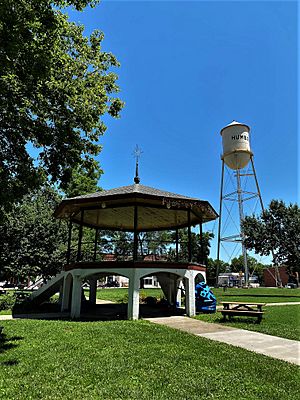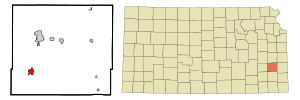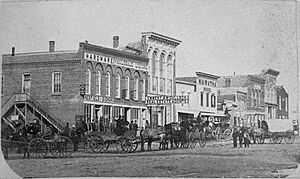Humboldt, Kansas facts for kids
Quick facts for kids
Humboldt, Kansas
|
|
|---|---|

City Square Park Bandstand and City Water Tower (2021)
|
|

Location within Allen County and Kansas
|
|

|
|
| Country | United States |
| State | Kansas |
| County | Allen |
| Founded | 1857 |
| Incorporated | 1878 |
| Named for | Baron von Humboldt |
| Area | |
| • Total | 1.50 sq mi (3.89 km2) |
| • Land | 1.49 sq mi (3.87 km2) |
| • Water | 0.01 sq mi (0.02 km2) 0.69% |
| Elevation | 974 ft (297 m) |
| Population
(2020)
|
|
| • Total | 1,847 |
| • Density | 1,231/sq mi (474.8/km2) |
| Time zone | UTC-6 (CST) |
| • Summer (DST) | UTC-5 (CDT) |
| ZIP code |
66748
|
| Area code | 620 |
| FIPS code | 20-33450 |
| GNIS ID | 485596 |
Humboldt is a city in Allen County, Kansas, United States. It is located along the Neosho River. As of the 2020 census, about 1,847 people lived in the city.
Contents
History of Humboldt
Humboldt's Early Days (1800s)
Humboldt was founded in 1857 by German settlers. They came from Hartford, Connecticut, and arrived in the area in May 1857. The town was named after Baron von Humboldt.
Soon after, people started building the town. Orlin Thurston set up a steam sawmill in 1857. This helped build houses. The first frame building was put up by J.A. Coffey. In 1858, W.C. O'Brien opened the first gristmill (a mill for grinding grain) in the county. The first church was built in 1859 by the United Brethren Denomination.
In 1861, Humboldt was attacked by a group of raiders. These raiders took some recently freed African-Americans. The local guards and the Kansas 6th Cavalry fought back. One of the raider leaders, John Allen Mathews, was killed in a battle.
Humboldt officially became a village in 1866. It became a city in 1870. In October 1870, a railway was built through Humboldt. This railway is now part of the South Kansas and Oklahoma Railroad.
The County Seat "War"
Humboldt was the main town, or county seat, for Allen County for seven years (1858–1865). But then, Iola became the county seat. Humboldt had won two elections to be the county seat. However, another election in 1865 moved the county seat to Iola.
Many Humboldt residents felt the election was unfair. They said not enough people voted because soldiers were away fighting the American Civil War. Some even claimed the county seat was "stolen." Iola secured the seat by giving land to the county for public buildings. They also raised money to build a courthouse.
This kind of competition between towns was common in Kansas. It was often called a "county seat war."
Civil War and Fortifications
Humboldt was very involved in the American Civil War. On September 1, 1861, Confederate raiders attacked the town. They took property and kidnapped eight free Black people, possibly forcing them back into slavery. No one was killed, but some were hurt. Many raiders were chased down, and one leader was killed.
To protect the town, two local guard groups were formed. They protected Humboldt and scouted for enemies. Two buildings, O'Brien's Mill and W. W. Curdy dry goods store, were made stronger for defense.
Humboldt was attacked again on October 14, 1861. This time, the town was surprised. The 100 local guards surrendered because they couldn't defend against 330 raiders. O'Brien's Mill and most of the town were burned. This second attack was partly revenge for the killing of the raider leader Mathews.
After this, Humboldt's safety was taken very seriously. The town often had local guards or Army troops stationed there. Sometimes, the military base was called Post Humboldt. A strong building called a blockhouse was partly built. It was used as a headquarters and for recruiting soldiers.
Other places in town were also used by the military. German settlers built a church that became a supply store for the army. On the west side of town, cabins were built near the Neosho River. This area was called Camp Hunter. When more soldiers arrived, tents were set up. Today, only the German church building still stands. It was turned into a home in the 1950s.
In October 1864, a large raid threatened the area. Most troops went to fight this threat further east. The military post in Humboldt was staffed by troops until at least June 1865. When the troops left, the military buildings were no longer used.
Geography
Humboldt covers about 1.45 square miles (3.8 square kilometers). Most of this area is land, with a small amount of water.
The city is located on the east side of the Neosho River. It is about halfway between Iola to the north and Chanute to the south.
Climate
The weather in Humboldt has hot, humid summers. Winters are generally mild to cool. This type of climate is called a humid subtropical climate.
Population Information
| Historical population | |||
|---|---|---|---|
| Census | Pop. | %± | |
| 1870 | 1,202 | — | |
| 1880 | 1,542 | 28.3% | |
| 1890 | 1,361 | −11.7% | |
| 1900 | 1,402 | 3.0% | |
| 1910 | 2,548 | 81.7% | |
| 1920 | 2,525 | −0.9% | |
| 1930 | 2,558 | 1.3% | |
| 1940 | 2,290 | −10.5% | |
| 1950 | 2,308 | 0.8% | |
| 1960 | 2,285 | −1.0% | |
| 1970 | 2,249 | −1.6% | |
| 1980 | 2,230 | −0.8% | |
| 1990 | 2,178 | −2.3% | |
| 2000 | 1,999 | −8.2% | |
| 2010 | 1,953 | −2.3% | |
| 2020 | 1,847 | −5.4% | |
| U.S. Decennial Census | |||
2020 Census Details
In 2020, the 2020 United States census counted 1,847 people living in Humboldt. There were 796 households and 508 families. The population density was about 1,210 people per square mile.
Most people (88.36%) were white. About 6.06% of the population was Hispanic or Latino.
About 28.8% of households had children under 18. The average household had 2.5 people. The average family had 3.2 people.
The median age in the city was 41.9 years. About 23.3% of the population was under 18. About 21.5% were 65 years or older.
Local Events
Humboldt is known for its Biblesta parade. Churches, businesses, and groups create floats based on Bible stories. Other fun activities during Biblesta include music concerts and a bean feed.
Education
The community is served by the Humboldt USD 258 public school district. This district has three schools and serves about 498 students.
- Humboldt High School (grades 9–12)
- Humboldt Middle School (grades 6–8)
- Humboldt Elementary School (grades K–5)
Transportation and Infrastructure
The old highway goes through the center of town. The current U.S. Route 169 passes about one mile to the east.
Train service to Tulsa, Oklahoma and other places is available in Humboldt. The South Kansas and Oklahoma Railroad line ends on the city's east side.
The Allen County Airport is located a few miles northeast of Humboldt.
Notable People
Humboldt has been home to some famous people:
- Walter Johnson: A Hall of Fame pitcher. He won 417 games for the Washington Senators.
- George Sweatt: A player for the Kansas City Monarchs baseball team.
See also
 In Spanish: Humboldt (Kansas) para niños
In Spanish: Humboldt (Kansas) para niños


